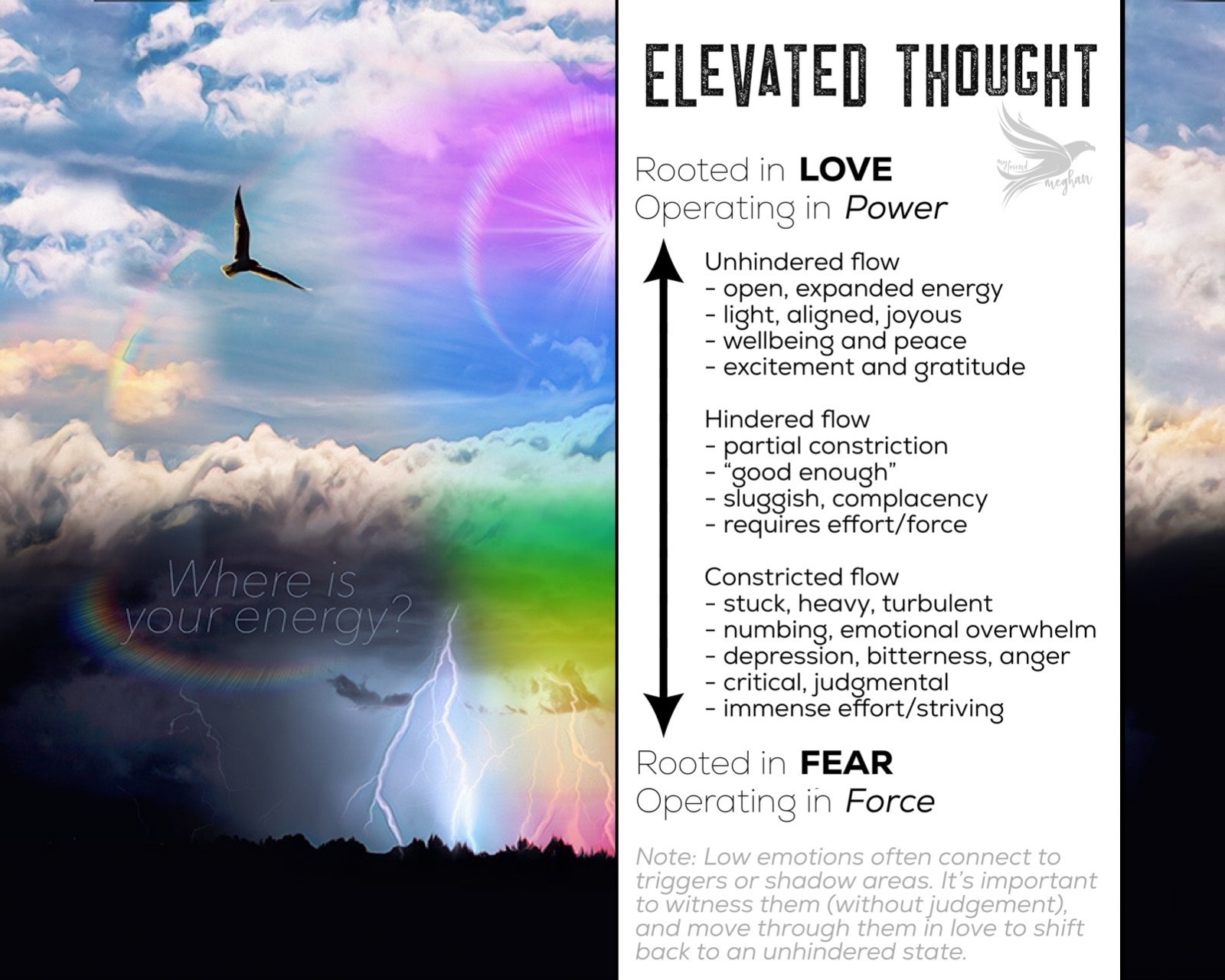When I first introduced the concept of Elevated Thought, it was about mapping the energetic terrain we move through every day. Whether we’re in unhindered, hindered, or constricted flow, how we feel gives us important clues about our alignment.
But knowing the map is only the beginning.
This post is about living it out—what it means to trust ourselves, walk forward with spiritual confidence, and move in sync with divine redirection, even when the next steps aren’t entirely clear. Because the truth is, Elevated Thought isn’t just a framework. It’s a way of walking.
Discern energy first, then content
This tool is foundational: before you respond, react, or engage with anything—a thought, a conversation, a situation, a piece of content—ask yourself: What kind of energy is behind this? Is it rooted in love or in fear?
This is the entry point to applying Elevated Thought in daily life. You’re not just looking at what is being said or done—you’re tuning into how it feels. Does the energy feel open, grounded, peaceful, curious? Or does it feel tight, anxious, pressuring, or chaotic?
The energy behind a thing often tells you more than the thing itself.
Here’s one way to visualize it: a loving parent may say, “Don’t touch the stove—it’s hot,” with calm concern and care. Another might launch into catastrophic warnings and fearful threats. The content could be similar, but the energy behind each is vastly different—and your nervous system feels that.
This isn’t just about interpreting others—it’s about interpreting your own inner landscape, too. If a thought crosses your mind and immediately tightens your chest or kicks up dread, pause. That’s likely constricted energy. If instead it brings curiosity or grounded conviction, even if it’s challenging, that’s often a sign of alignment (unhindered flow).
Discern the energetic root, then decide how (or if) you want to engage. That’s how you start living Elevated Thought—not just understanding it.
Be mindful of inherited caution
Sometimes the voices that taught us to be careful did so from a place of fear—not clarity. It’s worth noting how often caution has been conditioned into us, not because it was inspired, but because someone else was afraid.
It’s okay to acknowledge that. And then—more importantly—we get to choose differently. We get to anchor ourselves in love-based wisdom and learn to trust the divine guidance unfolding within us.
Trust allows movement
You don’t have to understand the entire path before taking the next step.
If you feel led to move in a certain direction, trust that divine course correction is available. We don’t need to second-guess ourselves endlessly out of fear. If Source (i.e. the Divine, Spirit) truly is as loving and present as we believe, then we can trust that missteps won’t destroy us—they’ll simply redirect us.
A “no” doesn’t have to shake our foundations. It can arrive as clarity, not panic.
If something sparked your curiosity, it matters
Inspired questions don’t arise by accident. If something stirs within you—an urge to ask, explore, or reach out—honor it. That spark may be leading you somewhere important, even if it stretches your comfort zone or challenges your previous understanding.
Let yourself follow the thread. Sometimes, clarity only comes through motion, so approach it with curiosity rather than judgement and allowing it to inform you.
Self-trust is sacred
There are systems and patterns that teach us not to trust our inner knowing. And when we internalize those messages, we become stuck—unable to move unless someone else says it’s safe. That’s not spiritual maturity. That’s fear in disguise.
Reclaiming trust in yourself is one of the most powerful steps you can take. You are not alone in the process—but the steps are still yours to take.
Redirection doesn’t require fear
A true spiritual “check” won’t come as a panic attack or shame spiral. It will feel like grounded clarity. Sometimes it shows up as a quiet “no,” a consistent sense of misalignment, a gentle pause, or simply a lack of peace around a particular idea or direction.
You may not always be able to explain why something doesn’t feel right—but honoring that inner check is part of learning to trust yourself (I call this honoring the resistance). It doesn’t have to be dramatic. It doesn’t have to make sense to anyone else. What matters is the clarity you feel inside, and your willingness to listen.
Your path doesn’t need permission
You are allowed to walk in alignment even when others don’t understand your choices. Your spiritual path is personal, and your connection to the Divine doesn’t require external validation.
What matters most is that you feel the resonance. That you are honest, open, and responsive to the nudges within.
Actionable Insights
- Build in a pause to check the energy. Before reacting, responding, or making a decision, create a simple pause—just long enough to ask: What energy is this rooted in? Love or fear? Clarity or chaos? This one moment of awareness creates space for Elevated Thought to come online, helping you shift from automatic patterns to intentional alignment.
- Trust the next step—even if the whole path isn’t clear. If you felt led to ask a question, honor the momentum that created. Move forward in trust, knowing you don’t need to micromanage divine guidance. If redirection is needed, it will come—not with fear, but with clarity. You are safe to trust your discernment. You are safe to walk.


Leave a Reply